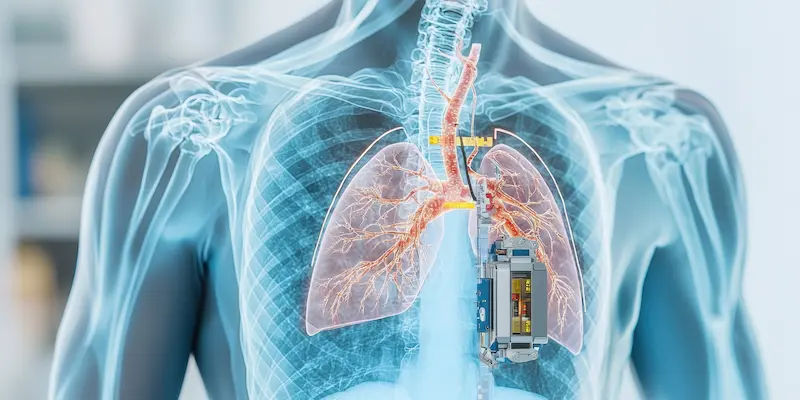Heart Rate: What’s Normal? Understanding Healthy Ranges and Factors
Learn what’s considered a normal heart rate, factors that influence it, and how regular monitoring supports a healthy heart and overall well-being.

Written by Dr.Sonia Bhatt
Last updated on 3rd Jul, 2025

Heart rate is a vital indicator of one’s overall health and well-being. It refers to the number of times your heart beats per minute, which varies based on activity levels, age, and overall fitness. Monitoring your heart rate can provide valuable insights into your cardiovascular health and help detect potential health issues early.
Whether you're an athlete tracking performance or someone managing a medical condition, understanding your heart rate is essential. In this article, we’ll explore what constitutes a normal heart rate, factors that influence it, and tips to maintain a healthy heart.
Understanding Normal Heart Rate
A healthy heart rate varies from person to person, depending on factors like age, fitness level, and activity. Here's a closer look at what constitutes average heart rate:
1. Average Heart Rate for Adults
For most adults, a normal resting heart rate ranges between 60 to 100 beats per minute (bpm). A rate within this range indicates that your heart is efficiently pumping blood throughout the body. However, being closer to the lower end of this range is often associated with better cardiovascular fitness.
2. Heart Rate Variations by Age and Fitness Level
Your heart rate tends to decrease with age and improve with fitness.
Children: 70–120 bpm (varies with age).
Adults: 60–100 bpm (resting).
Athletes: 40–60 bpm (due to improved cardiac efficiency).
Tracking these variations can help you tailor health strategies for optimal heart care.
Factors Influencing Heart Rate
Your heart rate is not something that remains static; it changes depending on various internal and external factors. Two key factors that influence your heart rate are discussed below:
1. Physical Activity and Exercise
During exercise or physical activity, your heart works harder to pump oxygen-rich blood to your muscles, causing your heart rate to increase. For instance:
Resting State: 60–100 bpm for most adults.
Moderate Activity: 100–160 bpm, depending on intensity.
High-Intensity Exercise: 160–200 bpm or more in some individuals.
Over time, regular exercise can lower your resting heart rate, as the heart becomes more efficient.
2. Stress and Emotional States
Stress, anxiety, and strong emotions like anger or excitement can temporarily raise your heart rate. This occurs because your body releases stress hormones like adrenaline, preparing you for a "fight or flight" response. Conversely, relaxation techniques like meditation or deep breathing can help lower your heart rate, promoting calmness.
Abnormal Heart Rates
You experience abnormal heart rate when your heart beats either too slowly or too quickly. This extreme variation can be a potential sign of underlying health issues. Abnormal heart rates are most classified into two categories:
1. Bradycardia: When Heart Rate is Too Slow
Bradycardia is a condition where the heart beats slower than 60 bpm in adults (outside of fitness-related reasons). Symptoms can include:
Fatigue
Dizziness
Shortness of breath
Common causes include aging, hypothyroidism, or certain heart conditions. In severe cases, untreated bradycardia can lead to complications like fainting or heart failure.
2. Tachycardia: When Heart Rate is Too Fast
Tachycardia refers to a heart rate exceeding 100 bpm while at rest. This can result from:
Stress or anxiety
Fever
Medical conditions like arrhythmia or hyperthyroidism
Symptoms may include palpitations, chest pain, or lightheadedness. Persistent tachycardia can strain the heart, increasing the risk of complications like stroke.
Measuring Your Heart Rate
Regularly monitoring your heart rate is an essential step in understanding your cardiovascular health. It helps you identify patterns, track fitness progress, and detect abnormalities early. Here’s how you can measure it effectively:
1. Using Manual Methods
You can measure your heart rate manually using these simple steps:
Place two fingers (index and middle) on your wrist (radial artery) or the side of your neck (carotid artery).
Press lightly until you feel a pulse.
Count the beats for 15 seconds and multiply by four to get your heart rate in beats per minute (bpm).
This method is quick, easy, and doesn’t require any equipment.
2. The Role of Technology and Wearable Devices
Modern technology has made heart rate monitoring more accessible and accurate. Wearable devices like fitness trackers and smartwatches can continuously monitor your heart rate, offering real-time data during workouts or rest. Advanced models even provide insights into heart rate variability and alert you to abnormal readings.
Both manual methods and wearables help you stay proactive about your heart health. Choose the one that fits your lifestyle for consistent tracking.
When to Seek Medical Attention
Monitoring your heart rate is crucial, but knowing when to consult a doctor is equally important. Recognizing the warning signs of heart problems and understanding your risk factors can help you seek timely medical care.
1. Signs of Potential Heart Problems
You should seek medical attention as soon as possible, if you notice the following symptoms:
Persistent or unexplained chest pain.
Dizziness, fainting, or lightheadedness.
Shortness of breath during rest or minimal activity.
Irregular heartbeats or palpitations.
Extreme fatigue that interferes with daily activities.
These could signal conditions like arrhythmia, heart attack, or other cardiovascular issues.
2. Risk Factors for Heart Disease
Some of the major factors that can potentially increase your risk of developing heart problems, include:
Chronic medical conditions: High blood pressure, diabetes, or high cholesterol.
Lifestyle factors: Smoking, obesity, sedentary behavior, and an unhealthy diet.
Family history: A genetic or hereditary predisposition to heart disease.
Age and gender: Risk increases with age, and you may be at a higher risk if you are a male. However, women may also be at a higher risk of developing heart disease.
Heart Health Tips for Maintaining a Normal Heart Rate
Maintaining a healthy heart rate is essential for overall well-being. Simple lifestyle adjustments can go a long way in promoting heart health and preventing abnormalities. Here are some effective strategies:
1. Diet and Nutrition
Opt for a heart-healthy diet rich in fruits, vegetables, whole grains, and lean proteins.
Include heart-friendly fats like omega-3 fatty acids found in fish, nuts, and seeds.
Limit intake of sodium, sugar, and unhealthy fats to reduce the risk of high blood pressure and heart disease.
Stay hydrated to help the heart pump blood efficiently.
2. Regular Physical Activity
Aim for at least 150 minutes of moderate aerobic activity or 75 minutes of vigorous activity weekly.
Activities like walking, cycling, swimming, and yoga can strengthen your heart and improve circulation.
Don’t overexert; monitor your target heart rate zone during exercise to stay within safe limits.
3. Stress Management Techniques
Practice relaxation techniques such as meditation, deep breathing, or mindfulness to lower stress-induced heart rate spikes.
Engage in hobbies or activities that bring you joy to improve emotional well-being.
Get adequate sleep, as poor sleep can negatively impact heart rate and overall health.
Special Considerations
While understanding heart rate is important for everyone, specific groups like athletes or individuals on medication require extra attention. Here’s how heart rate monitoring plays a role in these scenarios:
1. Heart Rate Monitoring for Athletes
Athletes often have lower resting heart rates, typically ranging from 40 to 60 bpm, due to their heart’s increased efficiency. However, this doesn’t mean athletes are immune to heart-related issues.
Tracking heart rate during training helps optimize performance by ensuring you’re exercising within your target heart rate zone.
Monitoring recovery heart rate (how quickly your heart rate returns to normal post-exercise) provides insights into fitness levels.
Overtraining can lead to elevated resting heart rates, which may indicate the need for rest or recovery.
2. Impact of Medication on Heart Rate
Certain medications can affect your heart rate, either increasing or decreasing it. Common examples include:
Beta-blockers: Lower heart rate by reducing the heart’s workload, often prescribed for high blood pressure or arrhythmia.
Stimulants: Medications for ADHD or some decongestants may elevate heart rate.
Thyroid medications: Can influence heart rate depending on dosage and thyroid function.
If you’re on medication, it’s essential to regularly monitor your heart rate and consult your doctor about any significant changes. Personalized advice ensures optimal health management.
Conclusion
Monitoring your heart rate offers valuable insights into your overall health, acting as a key indicator of cardiovascular fitness and potential health concerns. Whether it's understanding your resting heart rate, identifying your target heart rate during exercise, or spotting irregular patterns, keeping track of these metrics empowers you to take control of your well-being. Simple tools like fitness trackers or manual methods make heart rate monitoring accessible and easy to integrate into daily routines.
Regularly tracking your heart rate is more than just a number—it’s a proactive approach to long-term health. By staying aware of your heart’s activity, you can make informed lifestyle choices, detect early signs of health issues, and enhance your physical and mental fitness.
Consult Top Cardiologists
Consult Top Cardiologists

Dr. Anand Ravi
General Physician
2 Years • MBBS
Bengaluru
PRESTIGE SHANTHINIKETAN - SOCIETY CLINIC, Bengaluru

Dr. Tripti Deb
Cardiologist
40 Years • MBBS, MD, DM, FACC, FESC
Hyderabad
Apollo Hospitals Jubilee Hills, Hyderabad
Dr Moytree Baruah
Cardiologist
10 Years • MBBS, PGDCC
Guwahati
Apollo Clinic Guwahati, Assam, Guwahati

Dr. Zulkarnain
General Physician
2 Years • MBBS, PGDM, FFM
Bengaluru
PRESTIGE SHANTHINIKETAN - SOCIETY CLINIC, Bengaluru

Dr Nazneen Khan
Cardiologist
7 Years • M.B.B.S, M.D (MEDICINE), DrNB CARDIOLOGY
Pune
Apollo Clinic, Viman Nagar, Pune

